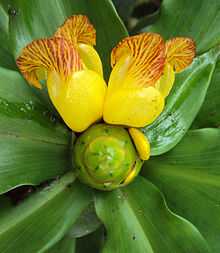Chamaecostus cuspidatus
| Chamaecostus cuspidatus | |
|---|---|
 | |
| Scientific classification | |
| Kingdom: | Plantae |
| (unranked): | Angiosperms |
| (unranked): | Monocots |
| (unranked): | Commelinids |
| Order: | Zingiberales |
| Family: | Costaceae |
| Genus: | Chamaecostus |
| Species: | C. cuspidatus |
| Binomial name | |
| Chamaecostus cuspidatus (Nees & Mart.) C.Specht & D.W.Stev. | |
| Synonyms[1] | |
| |
Chamaecostus cuspidatus, common name Fiery Costus or Spiral Flag, is a species of herbaceous plant in the Costaceae family native to eastern Brazil (States of Bahia and Espirito Santo).[1][2][3] Costus igneus, a plant from same family, in India known as Insulin plant due to its anti-diabetic properties.[4]
Chamaecostus cuspidatus has large fleshy looking leaves. The undersides of these large, smooth, dark green leaves have light purple shade. The leaves are spirally arranged around the stem, forming attractive, arching clumps arising from underground rootstocks. The maximum height of these plants is about two feet. The flowers are orange in color and are beautiful, 1.5-inch diameter. Flowering occurs during the warm months. And they appear to be cone-like heads at the tips of branches.[5]
Cultivation
In Siddha medicine, it is known as Kostum. It is being cultivated in Kashmir and the Himalayan regions for its root. It is related to the gingers and was originally part of the Zingiberaceae family. But now the Costus species and their kin have been reclassified into their own family, Costaceae.[2] The species reproduces vegetative by rhizome and birds disperse seeds when they feed on the fruits. Costus products are sometimes called Costus comosus and are edible in nature. The flower petals are quite sweet and nutritious. It's a lower grower and makes a great ground cover. The long red flower spikes of Costus pulverulentus are unique to the family and they are sure to create interest in the garden.[6][7] The plant grows very quickly. And the propagation is by stem cutting. It needs sunshine but it also grows in slightly shady areas. It is cultivated in India for its use in traditional medicine and elsewhere as an ornamental.
Medicinal Use
The dry leaves of Costus igneus (prepared according to proprietary ayurvedic procedure) showed significant control over blood sugar level in laboratory rats. The hypoglycemic effect could be due to release of insulin, insulin-sensitizing action or a combination of both. Reduction in the fasting and the postprandial blood sugar levels with leaves of insulin plant was comparable with that obtained with Glibenclamide 500 μg/kg at 250 mg/kg/day and 500 mg/kg/day of powdered leaves of the insulin plant.[4]
References
- ↑ 1.0 1.1 Kew World Checklist of Selected Plant Families
- ↑ 2.0 2.1 Specht, C. D. & D. W. Stevenson. 2006. A new phylogeny-based generic classification of Costaceae (Zingiberales). Taxon 55(1): 153–163.
- ↑ Tropicos, specimens of Chamaecostus cuspidatus (Nees & Mart.) C.D. Specht & D.W. Stev.
- ↑ 4.0 4.1 Shetty, Akhila (October 2010). "Effect of the insulin plant (Costus igneus) leaves on dexamethasone-induced hyperglycemia". International Journal of Ayurveda Research 1: 100–2. doi:10.4103/0974-7788.64396. PMID 20814523. Retrieved 11 December 2014.
- ↑ Forzza, R. C. 2010. Lista de espécies Flora do Brasil http://floradobrasil.jbrj.gov.br/2010. Jardim Botânico do Rio de Janeiro, Rio de Janeiro
- ↑ Devi VD, Urooj A (August 2008). "Hypoglycemic potential of Morus indica. L and Costus igneus. Nak.—A preliminary study". Indian J. Exp. Biol. 46 (8): 614–616. PMID 18814491.
- ↑ Arun N, Udhaya A & Rajaguru P (December 2011). "In vitro root induction and studies on antibacterial activity of root 3 extract of Costus igneus on clinically important human pathogens.". Journal of Microbiology and Biotechnology Research 1 (4): 67–76.